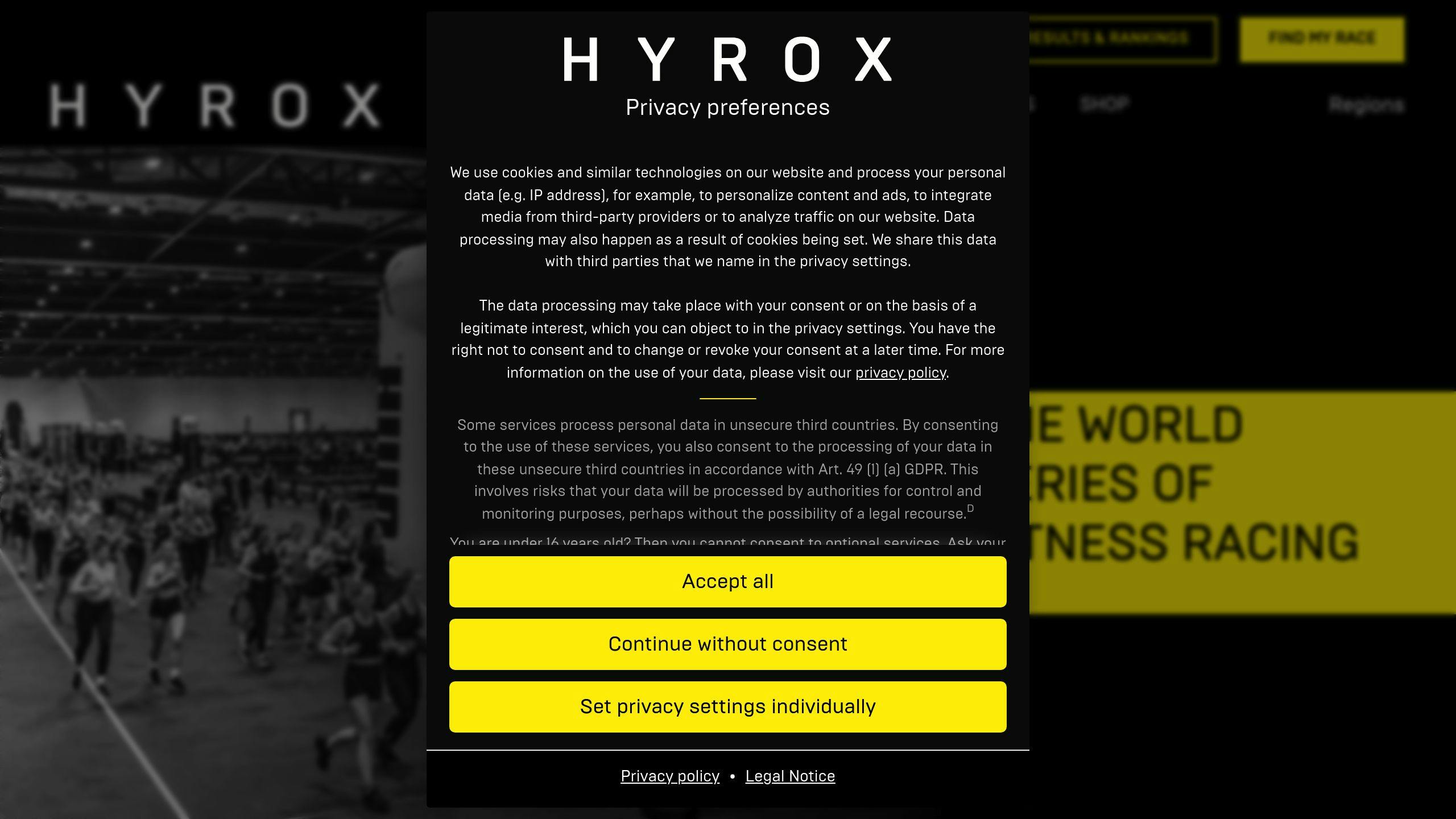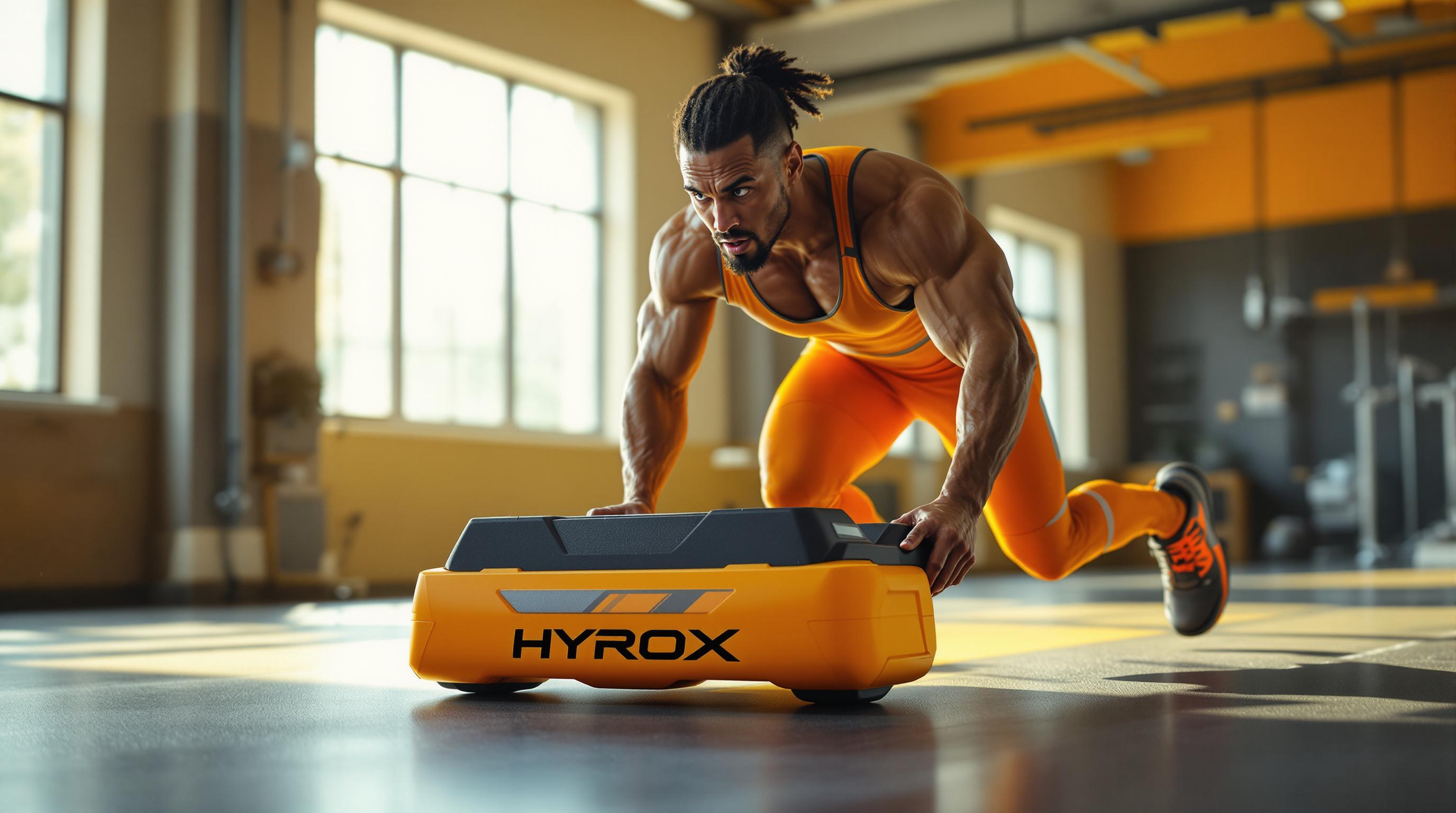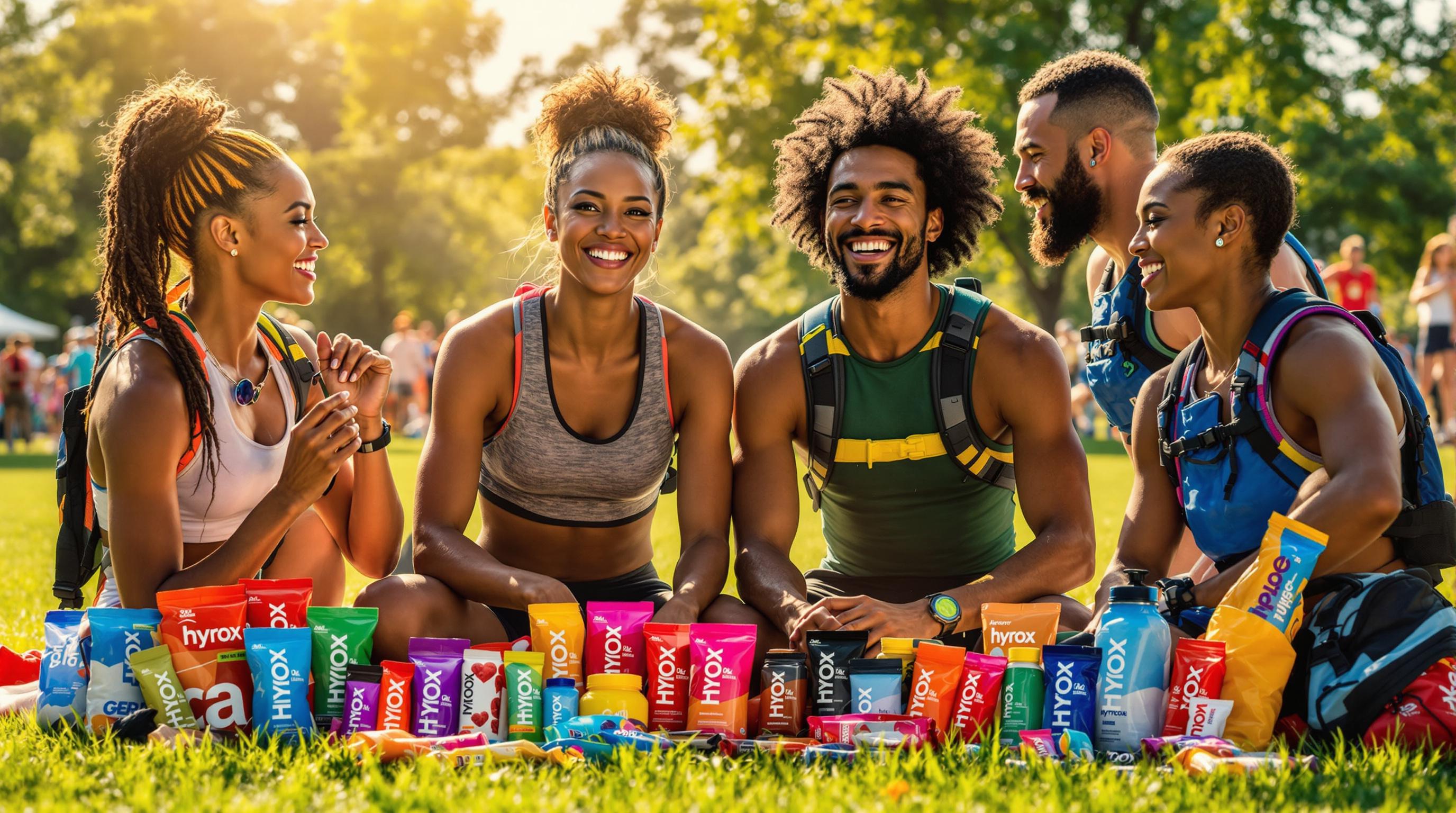Want to crush your next Hyrox competition? Knowing the difference between off-season and pre-season training is crucial. Here's a quick breakdown:
- Off-Season Focus: Build endurance, strength, and refine technique with low-intensity, high-volume workouts. Prioritize aerobic work (60-70%), strength training (20-30%), and recovery.
- Pre-Season Focus: Shift to race-specific, high-intensity training with reduced volume. Emphasize speed, power, and replicating race conditions.
Quick Comparison
| Aspect | Off-Season | Pre-Season |
|---|---|---|
| Goal | Build base fitness | Prepare for competition |
| Intensity | Low (65-75% max HR) | High (80-90% max HR) |
| Volume | Higher (5-6 sessions) | Lower (4-5 sessions) |
| Focus | Aerobic & strength work | Hyrox-specific drills |
| Recovery Days | 2-3 per week | 1-2 per week |
Mastering these phases ensures you're race-ready while avoiding burnout or injury. Let’s dive deeper into how to train smarter for Hyrox success.
Off-Season Training: Building a Base
Goals of Off-Season Training
Off-season training focuses on building General Physical Preparedness (GPP) by developing an aerobic base and improving overall strength. This phase lays the groundwork for a smooth shift to race-focused training when the pre-season begins.
Elements of an Off-Season Program
A good off-season program balances various training components to establish a solid fitness foundation. Here's how the focus is typically distributed:
| Focus Area | Time | Priority |
|---|---|---|
| Aerobic Work | 60-70% | Long, steady-state cardio |
| Strength Training | 20-30% | Compound lifts |
| Skill Development | 10-20% | Exercise technique |
Weekly training often includes recovery-focused activities and progressive overload, such as:
- Compound lifts like squats, deadlifts, and overhead presses
- Steady-state cardio performed at 60-70% of max heart rate
- Mobility exercises and cross-training
- Drills for movements specific to Hyrox events
Benefits of Off-Season Training
The off-season is an ideal time to focus on areas that directly influence overall performance. Some of the key benefits include:
- Reducing Injury Risk: Lower-intensity workouts help with recovery and correcting muscle imbalances.
- Building Strength: Develop overall strength without the pressure of competition.
- Improving Aerobic Capacity: Steady-state cardio enhances cardiovascular endurance.
- Refining Technique: Practice and improve movement patterns to prepare for competition-specific exercises.
These elements create a strong base for the high-intensity demands of pre-season training.
Pre-Season Training: Getting Ready for Competition
Goals of Pre-Season Training
Pre-season training is when athletes shift their focus from general preparation to gearing up for competition. This phase emphasizes building sport-specific conditioning tailored to Hyrox events. The goal? Train in a way that mirrors race conditions, boosts power output, and sharpens speed for Hyrox-specific movements.
During this time, training intensity ramps up while overall volume is reduced. This helps athletes avoid burnout and stay sharp for race day. Around 50-60% of training time is spent on race-specific drills, ensuring readiness for the unique demands of the competition.
"Pre-season training for Hyrox is all about specificity. You need to replicate the demands of the race in your workouts to be truly prepared for competition day." - Hunter McIntyre, 4-time Hyrox World Champion [1]
This phase is all about narrowing the focus - from general fitness to targeted preparation.
Elements of a Pre-Season Program
Pre-season programs are different from off-season training. Here, the emphasis is on intensity rather than volume. Weekly sessions include high-intensity intervals, race simulations, and drills for specific stations like sled pushes and wall balls.
Key elements of pre-season training:
- High-intensity intervals to build speed and stamina.
- Race simulations to replicate competition conditions.
- Station-specific technique drills for movements like lunges or burpees.
- Active recovery to manage fatigue and support adaptation.
Workouts become more focused and demanding, with athletes fine-tuning their technique and building endurance for each Hyrox element.
Advantages of Pre-Season Training
Pre-season training offers several benefits that directly impact performance on race day:
- Race-Specific Conditioning: Prepares athletes for the alternating run-and-station format by targeting the exact energy systems and movement patterns needed.
- Better Transitions: Practicing station-to-station transitions minimizes wasted time during the race.
- Mental Readiness: Simulating race conditions builds confidence and reinforces technique refined during the off-season.
- Performance Improvements: Pinpointing and addressing weaknesses ensures athletes are at their best when it matters most.
A typical pre-season phase lasts 8-12 weeks, with 4-6 sessions per week. Tracking recovery metrics during this time helps athletes manage the increased intensity and adapt effectively.
Hyrox Off-Season Training with Markus Frison

sbb-itb-8bcd5e0
Differences Between Off-Season and Pre-Season Training
Both off-season and pre-season training play a key role in preparing for Hyrox events, but they differ in intensity, exercise focus, and recovery strategies. Knowing these differences can help athletes fine-tune their approach to maximize performance.
Training Volume and Intensity
Off-season training focuses on building a solid base with higher volume and lower intensity. Athletes typically train 5-6 times a week, with sessions lasting 60-90 minutes, working at 65-75% of their maximum heart rate. The goal here is to improve aerobic capacity and general strength.
Pre-season, on the other hand, shifts gears. Training volume decreases to 4-5 sessions per week, lasting 45-60 minutes, but intensity ramps up to 80-90% of maximum heart rate. This prepares athletes for the specific demands of Hyrox events.
| Training Aspect | Off-Season | Pre-Season |
|---|---|---|
| Weekly Sessions | 5-6 sessions | 4-5 sessions |
| Session Duration | 60-90 minutes | 45-60 minutes |
| Heart Rate Zones | 65-75% max HR | 80-90% max HR |
| Recovery Days | 2-3 per week | 1-2 per week |
| Training Focus | Aerobic base | Hyrox-specific conditioning |
Exercise Selection
In the off-season, the focus is on general fitness using a wide variety of exercises. Strength training includes compound lifts like squats and deadlifts, along with cross-training activities such as swimming or cycling. These exercises build endurance and strength without the pressure of competition.
"The off-season is about building a solid foundation of strength and endurance, while the pre-season is where we fine-tune our athletes for the specific demands of Hyrox competition." - Jake Dearden
Pre-season workouts shift to Hyrox-specific movements. Exercises are tailored to mimic competition demands, and cross-training becomes more performance-focused. This phase is all about refining skills and preparing for the unique challenges of the event.
Recovery and Periodization
Off-season recovery is more relaxed, with 2-3 rest days per week and light mobility work. Training follows a linear progression over 12-16 weeks, gradually increasing workload to build capacity.
In pre-season, recovery becomes more structured and data-driven. Athletes often include planned deload weeks every fourth week to manage the increased intensity. Recovery methods like ice baths, improved sleep, and focused nutrition are emphasized to handle the stress of high-intensity training. Periodization shifts to an undulating or block model, alternating between intense training weeks and recovery periods to maintain peak performance and avoid burnout as competition nears.
Moving from Off-Season to Pre-Season
Progression Strategies
Once off-season fitness is in place, athletes need to shift gears with a planned progression. Increasing training volume by 10-15% every 2-3 weeks, while adding more Hyrox-specific exercises, helps ensure steady improvement. This approach follows periodization principles, promoting consistent adaptation.
Here's how training focus evolves over time:
| Training Phase | Duration | Focus (Off-Season/Pre-Season) |
|---|---|---|
| Introductory | Weeks 1-4 | 70/30 |
| Development | Weeks 5-8 | 50/50 |
| Specialization | Weeks 9-12 | 30/70 |
| Pre-Competition | Weeks 13-16 | 10/90 |
"The transition from off-season to pre-season is critical for Hyrox athletes. It's where we lay the foundation for peak performance while minimizing injury risk. A well-structured plan that gradually increases intensity and incorporates sport-specific elements is key to success." - Dr. Sarah Thompson, Sports Physiologist
Nutrition and Recovery Adjustments
As workouts become more intense, nutritional needs also increase. Daily calories should go up by 300-500, with 5-7g of carbs per kg and 1.6-2.2g of protein per kg to support energy demands.
Recovery becomes just as important as training. Key areas to focus on include:
- Sleep: Aim for 7-9 hours each night.
- Post-Workout Nutrition: Include 20-30g of protein and 60-90g of carbs after training.
- Mobility Work: Regular sessions to maintain flexibility and prevent stiffness.
Mental Prep and Goal Setting
Mental readiness is just as crucial during this phase. Athletes should set clear baseline metrics and create SMART goals tailored to the pre-season. This shift moves focus from general fitness to competition-specific preparation.
Tracking progress with measurable benchmarks keeps motivation high and helps fine-tune training plans. Regular evaluations ensure adjustments can be made to stay on the right path toward peak performance.
Conclusion: Optimizing Your Hyrox Training
Why Structured Training Plans Matter
Achieving success in Hyrox demands a mix of building a strong foundation during the off-season and focusing on specific skills as the competition approaches. Research shows that following a well-organized training plan not only boosts performance but also reduces the chance of injuries by pacing your progress effectively.
Practical Tips for Hyrox Athletes
Here’s how to put these ideas into action:
- Monitor Your Progress: Keep an eye on metrics like heart rate, power output, and strength improvements. This information helps you gauge when it’s time to shift your training focus.
- Don’t Skimp on Recovery: As workouts get tougher closer to competition, rest becomes even more important. Get 7-9 hours of sleep each night and include active recovery strategies to stay at your best.
- Train Smarter, Not Just Harder: Keep a balance between strength and endurance work all year long by adjusting your training focus at the right times.



